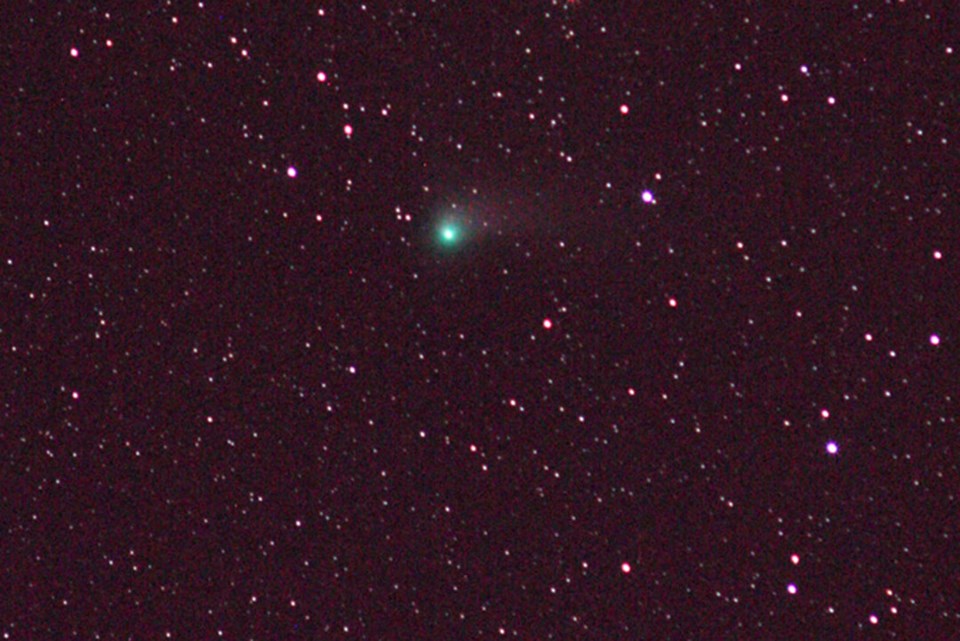What better way to open the new year than by spotting a hopefully bright comet? It is referred to as comet C/2022 E3 (ZTF) and it could be putting on a decent show in northern skies throughout January. This will be a great chance to test that new set of binoculars or telescope you may have received for Christmas.
This ice mountain was discovered in March of 2022 by the wide-survey camera operating at the Zwicky Transient Facility. At first, astronomers believed the tiny, distant object was an asteroid. However, it quickly brightened as it passed the planet Jupiter on its way to the inner solar system to round the sun. At this distance, the sun’s influence begins to react with the comet’s frozen elements, compounds and water ice causing it to sublimate from a solid to a gas. The comet now begins to glow and in most cases forms an ion (gas) and sometimes even a dust tail. Now it was classified as a comet.
The comet appears green in colour and is the result of the breakdown of a reactive molecule called dicarbon and is sporting a faint ion tail only. C/2022 is well placed in northern skies and be seen all night long. It will be close to Polaris (the North Star) at the and of January. Unlike a meteor that streaks for a fraction of a second as it vaporizes in our atmosphere, comets are interstellar visitors that slowly move against the background stars from night to night and are located millions of kilometres away.
C/2022 E3 (ZTF) closest approach to the sun called perihelion occurred Jan. 12 at 160 million kilometres distance. Over the next few weeks, the comet will approach our planet (not directly). Its closest approach to the Earth will occur on Feb. 2 at a safe distance of 42 million kilometres. There is a finder chart on my website www.wondersofastronomy.com.
In general, comets are unpredictable. Even though calculations suggest it will be visible in the dark countryside on a clear moonless night, it could easily fizzle away like Comet Kohoutek back in 1973. Expectations of being the brightest comet of the 20th century and given the name “Comet of the Century,” Kohoutek was bright but much dimmer than predicted. As my long-time friend and comet hunter David Levy says, “Comets are like cats: they have tails, and do precisely what they want.”
Throughout any given year, amateur astronomers can observe a handful of comets but only through telescopes as they are too faint to be seen just by looking up. Hopefully, C/2022 E3 (ZTF) will not disappoint and allow you to see this particular visitor that is estimated to have last returned to our neck of the cosmic woods some 50,000 years ago. This was the period of the early homo sapiens. Unfortunately, the Neanderthals became extinct some 10,000 years after the last approach of this comet.
As the weeks go by, the moon will rise later and later and show less of its illuminated phase meaning less sky glow. The new moon occurs on Jan. 21. This comet is not expected to be as great as Comet Neowise back in July 2020. However, you still have a chance to see a somewhat bright space tourist that will return 50,000 years from now.
You can also try your hand at wide-angle astrophotography with a DSLR camera, cable release and a sturdy tripod. If you do not own an automated telescope, there are good camera trackers on the market that allow you to take long one or two-minute exposures and still have pinpoint stars. The colourful comet would register on the camera’s CCD chip. Experiment with the manual exposure settings. After all, pixels are free.
Clear skies.
Known as “The Backyard Astronomer,” Gary Boyle is an astronomy educator, guest speaker, monthly columnist for the Royal Astronomical Society of Canada as well as a STEM educator. He has been interviewed on more than 55 Canadian radio stations as well as television across Canada and the U.S. In recognition of his public outreach in astronomy, the International Astronomical Union has honoured him with the naming of Asteroid (22406) Garyboyle. Follow him on Twitter @astroeducator, Facebook and his website www.wondersofastronomy.com.



